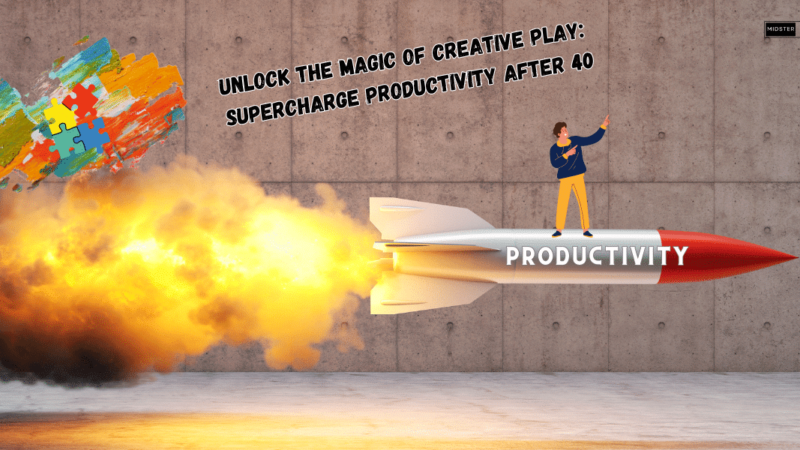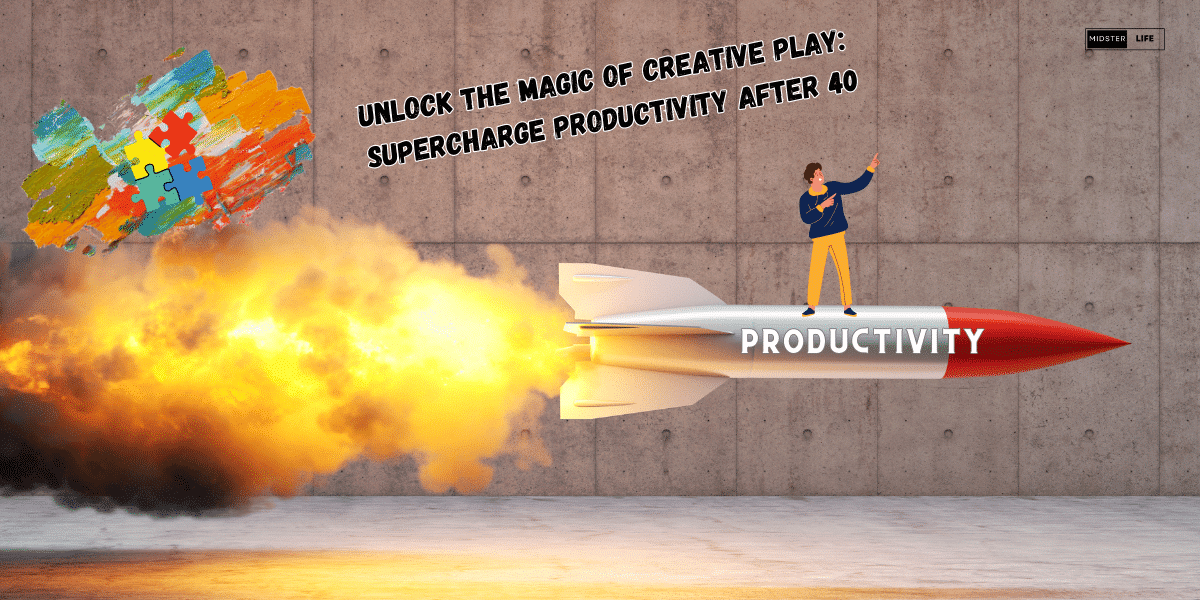Unlock the Magic of Creative Play: Supercharge Productivity After 40
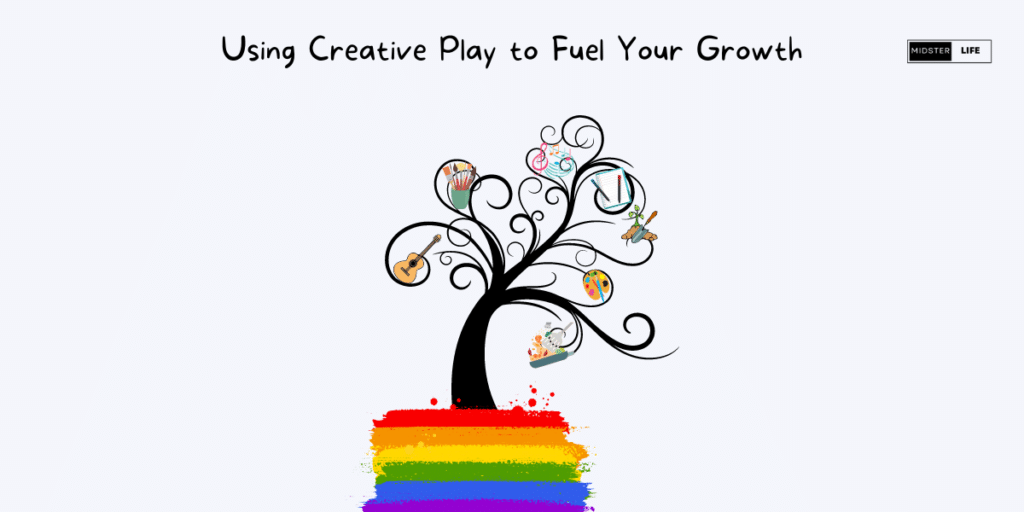
- Unlock the Magic of Creative Play: Supercharge Productivity After 40
- Using Creative Play to Fuel Your Growth
- Play and Productivity: The Unlikely Bedfellows
- The Connection Between Play, Curiosity, and Motivation
- Understanding Intrinsic Motivation and Why It’s Important
- The Power of Creative Play: How it Stimulates Dopamine and Motivation
- Transforming Creative Play into Productive Habits
It was the third night in a row that I was still up working late. My wife disapprovingly shook her head, telling me, “It’s no good staring at that screen so late. You need time to unwind.”
I couldn’t stop, though.
I was editing a film and couldn’t get the scenes to work how I wanted. I couldn’t solve the puzzle. I couldn’t stop thinking about it. I was obsessed.
When I worked in a corporate job, I’d worked late nights before, begrudgingly, desperate to satisfy some outside force, some deadline hanging over me. It never felt good. It felt like work.
But now, editing this film late at night. This felt like play, and play feels good, doesn’t it?
Using Creative Play to Fuel Your Growth
We all remember those carefree childhood days, don’t we? When hours disappeared into an enchanting world of play, whether we were battling imaginary dragons or creating elaborate tales with our action figures.
Back then, play was how we explored our world and how we learned and understood the social and moral rules around us.
Now in our 40s, we often find ourselves juggling multiple responsibilities — careers, families, personal goals — leaving us with little time for play.
But what if we could tap back into our playful side and turn play into a personal growth and productivity tool? What if embracing our creativity could reignite our motivation and drive and make us more purposeful in our actions?
This is what this post is about. It’s about using creative play to boost your productivity and help you discover purpose and passion in your 40s.
Play and Productivity: The Unlikely Bedfellows
People often see creativity and productivity as opposing forces. Creativity needs time, demands quality, and doesn’t want to rush. In contrast, productivity wants to get things done in the most efficient way.
But creativity can lead to innovative ideas that improve efficiency while being productive can free up the time and mental space necessary for creative thinking.
By engaging in creative play, we can strike the right balance between creativity and productivity. Leading to not just more output but better, more innovative output.
The Connection Between Play, Curiosity, and Motivation

Do you remember, as a child, how a burning curiosity drove play?
You’d build a castle out of blocks and wonder, “Can I make it taller? Can I build a bridge between two castles?” Every game was a journey of discovery fuelled by your curiosity.
As adults, we often overlook the power of curiosity, but it’s a potent motivator. We naturally drive to explore, learn, and understand when curious about something. This intrinsic motivation propels us forward, even when things get tough.
According to a study at the University of Michigan, curiosity is a critical element in our drive for knowledge and learning. It engages our intrinsic motivation and makes the learning process enjoyable, enhancing our persistence, performance, and, ultimately, our productivity.
Creative play, by its nature, stimulates curiosity. We enter a state of exploration and experimentation when we engage in creative activities. We ask questions, seek answers, and play around with ideas.
Whether trying to master a new recipe, writing a short story, or learning to play a musical instrument, we become more engrossed when our curiosity is piqued.
It’s a virtuous cycle – the more we play, the more curious we become and the more motivated we are to continue playing and exploring.
Understanding Intrinsic Motivation and Why It’s Important

What is Intrinsic Motivation
So what do we mean by intrinsic motivation?
Simply put, intrinsic motivation comes from within. It’s the drive to engage in an activity for its own sake, for the pure enjoyment and satisfaction it brings, rather than for any external rewards or outcomes.
When you’re intrinsically motivated, curiosity and interest drive your actions. You’re eager to learn, to explore, to challenge yourself. You’re not just going through the motions; you’re fully engaged and invested in what you’re doing.
The activity feels like play.
The Power of Creative Play: How it Stimulates Dopamine and Motivation
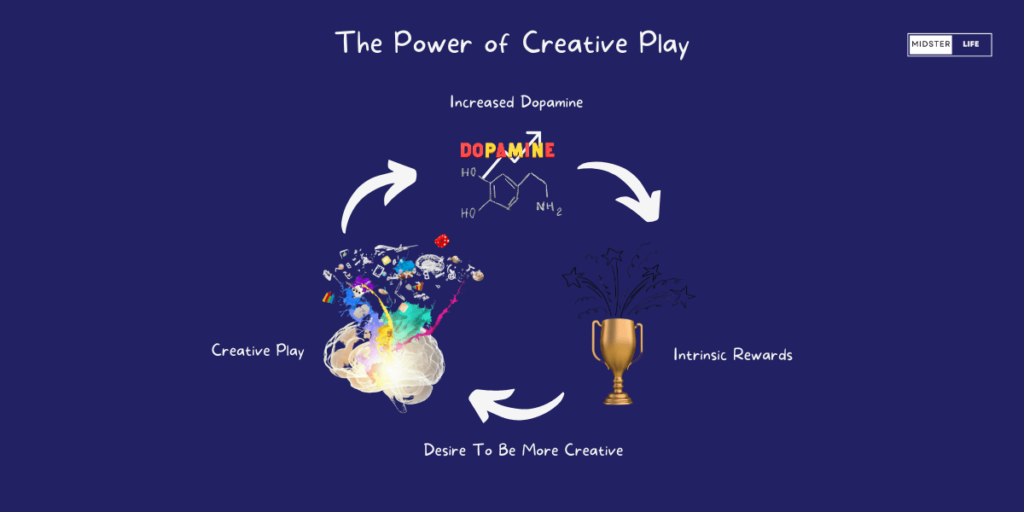
Definition and Examples of Creative Play
Creative play refers to engaging in activities that allow our imagination, innovation, and expression to flourish.
It’s often characterized by a lack of rules or structure, focusing instead on exploration, improvisation, and making connections between seemingly unrelated concepts.
Creative play for adults includes painting, writing, dancing, and even participating in brainstorming sessions or problem-solving games.
The Neuroscience That Links Creative Play and Intrinsic Motivation
When we engage in creative play, our brains undergo complex processes that result in the release of certain neurotransmitters, such as dopamine.
Often referred to as the “feel-good hormone,” dopamine is responsible for the reward system in the brain. It contributes to feelings of pleasure, satisfaction, and motivation.
When our brains experience better-than-expected outcomes or anticipation of rewards, dopamine release is triggered, reinforcing our actions and promoting a desire to repeat them.
Creative play elevates our mood and activates the noradrenergic, dopaminergic, and serotonergic pathways responsible for our creative drive. These pathways contribute to our emotions, motivation, and reward processing, all essential to creativity and innovation.
The Impact of Creative Play on Productivity and Performance
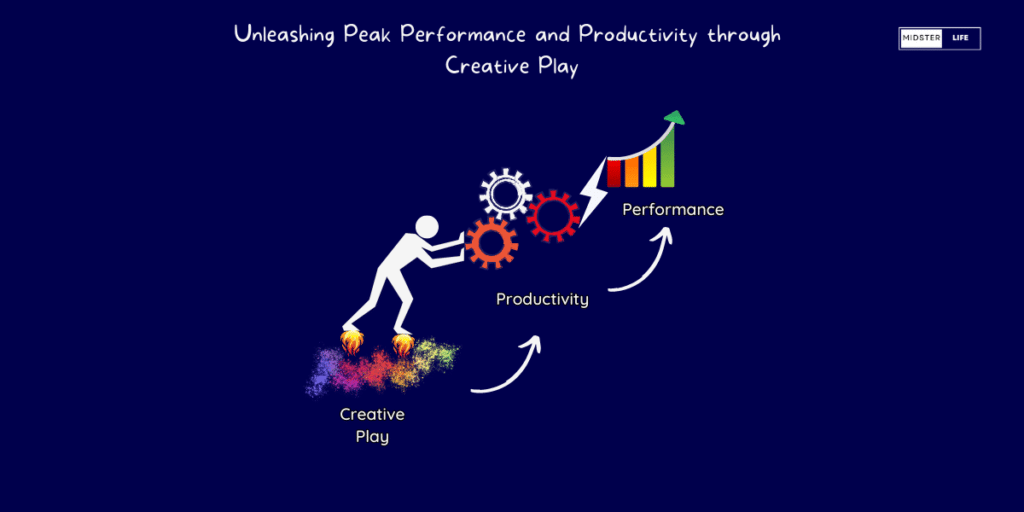
You might wonder, “How can playing around make me more productive?” It’s a fair question, so let’s address it.
As we’ve seen, creative play fuels curiosity, enhancing our intrinsic motivation. But there’s more to the story. When intrinsically motivated, we’re more likely to fully engage in what we’re doing. We put in more effort, persist longer in the face of challenges, and perform better. In other words, we become more productive.
But How Does This Translate Into Our Personal Lives, Especially In Our 40s?
Imagine you are learning to play the guitar. As you’re learning to play, you’re likely to encounter challenges. Maybe you’re struggling to master a tricky chord or keep up with a fast tempo. But because you’re intrinsically motivated and engaged in a form of play that interests you, you stick with it. You practice more, try different strategies, and gradually improve. And as you see your progress, your motivation and productivity increase even more.
Moreover, engaging in creative play can also enhance your productivity in other areas of your life. For instance, the patience and persistence you develop while learning to play the guitar could translate into greater focus and perseverance in your work tasks. The creative problem-solving skills you hone while experimenting with a new recipe could spark innovative ideas for a project at work.
The bottom line is this: By igniting your intrinsic motivation, creative play can boost your productivity and performance in both your personal and professional life. It’s a fun, fulfilling, and effective way to up your productivity game, especially in your 40s when you’re juggling multiple responsibilities.
Transforming Creative Play into Productive Habits
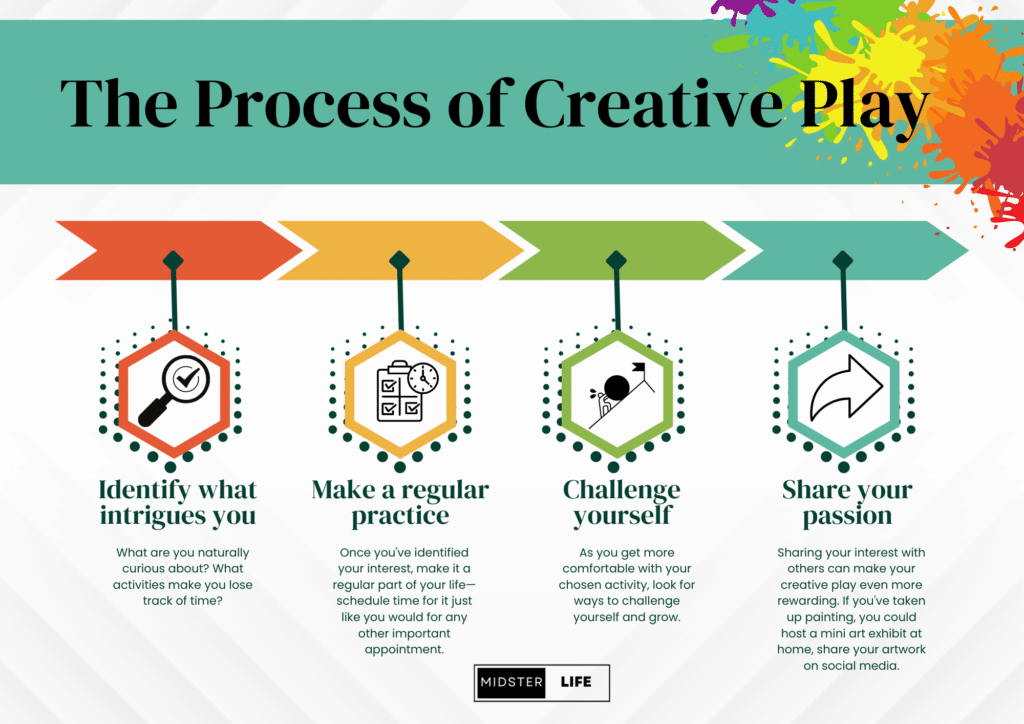
The Process of Identifying Creative Interests
Creative play isn’t just a powerful motivator or productivity booster; it’s also a compass that can guide us toward more purposeful action. When we engage in activities that genuinely interest us, spark our curiosity, and feel like play, we can discover passions and purpose we might not have been aware of.
Suppose you spend hours absorbed in gardening, observing how plants grow and thrive. In that case, this might indicate a deep-seated interest in nature or biology. This could inspire you to become more involved in environmental causes or even consider a career shift toward a field related to nature conservation.
Or, you’ve discovered a knack for storytelling while writing short stories. You find it fulfilling to create characters and worlds, to express your thoughts and ideas through words. This could lead you to pursue writing more seriously, starting a blog, writing a book, or even just journaling regularly to capture your thoughts and reflections.
In other words, the activities we love to play in can illuminate our interests and values, leading to more purposeful and aligned actions in our lives.
4 Tips to Turn Creative Play Into Actionable Goals
Here are some tips for translating the passion discovered through creative play into actionable goals and tasks:
- Identify What Intrigues You: Start by identifying what genuinely interests you. What are you naturally curious about? What activities make you lose track of time? For example, if you are engrossed in cooking shows or always taking over the grill at family gatherings. You may have a passion for cooking that’s worth exploring further.
- Make it a Regular Practice: Once you’ve identified your interest, make it a regular part of your life—schedule time for it just like you would for any other important appointment. For instance, if you’ve discovered a love for writing, set aside a dedicated ‘writing hour’ each day, or make it a weekend ritual.
- Challenge Yourself: As you get more comfortable with your chosen activity, look for ways to challenge yourself and grow. If photography is your creative play, you might learn a new technique, explore a different genre, or even participate in a local photography competition.
- Share Your Passion: Sharing your interest with others can make your creative play even more rewarding. If you’ve taken up painting, you could host a mini art exhibit at home, share your artwork on social media, or volunteer to teach basic painting skills at a local community center.
Incorporating Creative Play into Daily Life

I know what you might think: “This all sounds great, but how do I actually incorporate creative play into my busy life?” Well, it’s simpler than you think. It certainly doesn’t require you to shirk your responsibilities or invest in an arsenal of art supplies (unless, of course, you want to). Here are some practical steps you can take:
- Dedicate Time for Play: Just as you might block time in your schedule for meetings or gym sessions, do the same for your creative play. It could be as little as half an hour a day or a couple of hours every weekend. The key is consistency.
- Choose Activities That Truly Interest You: Your creative play should be something you look forward to, not another task on your to-do list. Whether painting, cooking, writing, or playing a musical instrument, choose an activity that sparks your curiosity and joy.
- Create a Play-Friendly Environment: Set up a space in your home to engage in your chosen activity without distractions. It doesn’t have to be an entire room; a quiet corner with your art supplies or a comfortable chair with your reading materials can work just as well.
- Don’t Fear Failure: The goal of creative play isn’t to produce a masterpiece; it’s to explore, learn, and fuel your intrinsic motivation. Don’t be afraid to make mistakes or try new things.
- Connect with Like-Minded Individuals: Joining a community of people who share your interests can make your creative play more enjoyable and rewarding. Look for local clubs or online groups where you can share your experiences and learn from others.
The Role of Consistency in Developing Productive Habits
Lastly, consistency is crucial in transforming our creative interests into productive habits. According to scientific research, forming a habit takes an average of between 59 and 70 days. By consistently focusing on a specific creative pursuit and dedicating regular time to it, we reinforce the habit loop and, with time, turn it into a natural, ingrained part of our lives.
Consistency can enhance our productivity and unleash our creativity by fostering the following characteristics:
- Establishing a structure and routine that supports regular creative engagement
- Building momentum in our creative endeavors as we progress and grow
- Cultivating a sense of mastery and expertise in our chosen interests
In our 40s, amidst the hustle and bustle of life, it’s easy to view play as an indulgence rather than a necessity. However, as we’ve explored, creative play isn’t just about having fun—it catalyzes personal growth, increased productivity, and a more purposeful life.
By stimulating dopamine production and intrinsic motivation, it helps us find joy in what we do, transforming our interests into actions and our actions into habits.
It breaks the myth that productivity and creativity are mutually exclusive, showing us they can fuel each other.
So, let’s take a moment to bring back the play in our lives. Whether painting, writing, dancing, or even building a model plane, let’s embrace these activities not as distractions but as pathways to a more creative, productive, and fulfilled life.
Because, in the end, it’s not just about getting more done—it’s about loving what we do and doing what we love.

